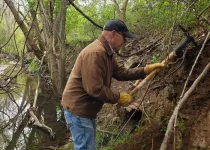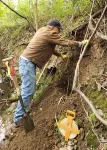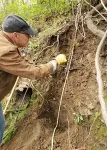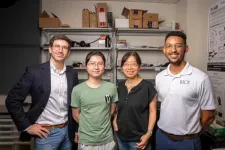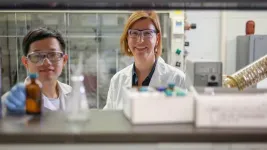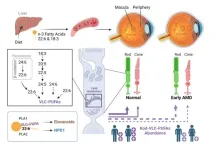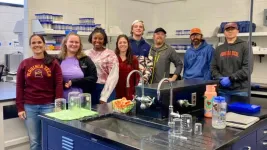(Press-News.org) DURHAM, N.C. – For much of the last century, many cities across the United States and Canada burned their trash and waste in municipal incinerators. Most of these facilities were closed by the early 1970s due to concerns about the pollution they added to the air, but a new Duke University study finds that their legacy of contamination could live on in urban soils.
“We found that city parks and playgrounds built on the site of a former waste incinerator can still have greatly elevated levels of lead in their surface soils many decades after the incinerator was closed,” said Daniel D. Richter, professor of soils at Duke’s Nicholas School of the Environment, who co-led the research.
Exposure to lead in soil has been linked to potential long-term health problems, particularly in children. These include possible damage to the brain and nervous system, slowed growth and development, and learning and behavioral problems.
To conduct their study, Richter and his students collected and analyzed surface soil samples from three city parks in Durham, N.C. that are located on former incinerator sites closed in the early 1940s.
Samples collected from a two-acre section of East Durham Park contained lead levels over 2000 parts per million, more than five times higher than the current U.S. Environmental Protection Agency (EPA) standard for safe soils in children’s play areas.
Samples collected from Walltown Park mostly contained low lead levels, “but about 10% were concerning and a few were very high,” Richter noted.
Samples collected from East End Park all contained levels of soil lead below the current EPA threshold for children’s safety “and presented no cause for concern,” he said.
The sharp differences in lead levels between the three parks underscores the need for increased monitoring, he stressed.
“Determining where contamination risks persist, and why contamination is decreasing at different rates in different locations, is essential for identifying hotspots and mitigating risks,” Richter said. “Many cities should mobilize resources to do widespread sampling and monitoring, and create soil maps and, more specifically, soil lead maps.”
“That’s where we really need to go,” Richter said. “Not just in Durham but in hundreds of other cities where parks, as well as churches, schools and homes, may have been built on former waste incinerator and ash disposal sites.”
By analyzing historic surveys of municipal waste management, the Duke team found that about half of all cities surveyed in the U.S. and Canada incinerated solid waste between the 1930s and 1950s.
“These incinerators burned all kinds of garbage and trash, including paint, piping, food cans and other products that contained lead back then,” Richter said. The leftover ash, in which lead and other contaminants were concentrated, was sometimes covered with a too-thin layer of topsoil or even spread around parks, new construction sites or other urban spaces as a soil amendment.
“Historical surveys indicate a lack of appreciation for the health and environmental hazards of city-waste incinerator ash. Back then, they didn’t know what we do now,” he said.
New technology could help make sampling and monitoring more feasible at the thousands of sites nationwide that may be contaminated, he added. Using a portable x-ray fluorescence instrument, his lab is now able to do a preliminary analysis on a soil sample for multiple metals, including lead, in just 20 seconds.
Making use of historical records about waste incineration and ash disposal could also speed efforts to identify hotspots. In their paper, Richter and his students provide histories gleaned from archived public works records, old street maps and newspaper clippings showing where ash was burned and disposed of in six sample cities: Los Angeles; New York City; Baltimore; Spokane, Wash.; Jacksonville, Fla.; and Charleston, S.C.
“This is something you could do for many cities to guide monitoring efforts,” Richter said.
“There’s been a lot of interest in mitigating lead exposure in cities, but most until now has been focused on reducing risks within the home. Our study reminds us that risks exist in the outdoor environment, too,” he said.
Richter and his students published their peer-reviewed findings Sept. 11 in Environmental Science & Technology Letters.
His co-authors on the new paper were Enikoe Bihari, a 2023 Master of Environmental Management graduate of the Nicholas School who conducted much of the research as part of her Master’s Project, and Garrett Grewal, a senior at Duke majoring in Earth and Climate Sciences.
Funding came from Duke University and the National Institute of Environmental Health Sciences (P42ES010356).
CITATION: “Legacies of Pre-1960s Municipal Waste Incineration in the Pb of City Soils,” Enikoe Bihari, Garrett Grewal, and Daniel D. Richter. Environmental Science & Technology Letters, Sept. 11, 2023. DOI: 10.1021/acs.estlett.3c00488
END
Urban parks built on former waste incineration sites could be lead hotspots
Legacy of contamination could still live on in the soil of parks, playgrounds and other urban spaces built on former municipal incinerator sites
2023-09-11
ELSE PRESS RELEASES FROM THIS DATE:
You can leave your gloves on: Rice-developed material burns viruses, safe for skin
2023-09-11
HOUSTON – (Sept. 11, 2023) A new material that packs deadly heat for viruses on its outer surface while staying cool on the reverse side could transform the way we make and use personal protective equipment (PPE), cutting down the pollution and carbon footprint associated with current materials and practices.
The composite, textile-based material developed by Rice University engineers uses Joule heating to decontaminate its surface of coronaviruses like SARS-CoV-2 in under 5 seconds, effectively killing at least 99.9% of viruses. Wearable items made from the material can handle hundreds of uses with the potential for a single pair of gloves to prevent nearly ...
Not too big: Machine learning tames huge data sets
2023-09-11
LOS ALAMOS, N.M., Sept. 11, 2023 — A machine-learning algorithm demonstrated the capability to process data that exceeds a computer’s available memory by identifying a massive data set’s key features and dividing them into manageable batches that don’t choke computer hardware. Developed at Los Alamos National Laboratory, the algorithm set a world record for factorizing huge data sets during a test run on Oak Ridge National Laboratory’s Summit, the world’s fifth-fastest supercomputer.
Equally efficient on laptops and supercomputers, ...
UArizona Cancer Center researchers discover iron-targeting approaches to halt proliferation of cancer cells
2023-09-11
Researchers at the University of Arizona Cancer Center discovered a new class of iron-targeting compounds that hamper the proliferation of cultured malignant cells in a laboratory setting. The results of the study were published in the Journal of the American Chemical Society.
“Cancer cells are what we call ‘addicted’ to iron, and so we are making compounds that are able to interfere with the availability of iron in cancer cells,” said Elisa Tomat, PhD, professor in the Department of Chemistry ...
Experimental physicist David Weld to investigate the role of feedback and measurement in quantum systems
2023-09-11
(Santa Barbara, Calif.) — Experimental physicist David Weld’s experimental research interest lies in a question that has been around for a long time, but which we’re only now approaching the ability to investigate.
“There’s a really old interest in the quantum act of measurement,” he said. “It’s something that’s at the foundations of quantum mechanics and has been puzzling people for more than a century.”
Called the “measurement problem” and famously illustrated by Erwin Schrödinger’s ...
ORNL teams receive funding through DOE BRaVE initiative to study biopreparedness
2023-09-11
The Department of Energy’s Office of Science has selected three Oak Ridge National Laboratory research teams to receive funding through DOE’s new Biopreparedness Research Virtual Environment, or BRaVE, initiative.
BRaVE, announced earlier this year, aims to build on biopreparedness research that delivered high-impact results in the fight against COVID-19. In the height of the pandemic, DOE national laboratory scientists combined fields such as biology, high-performance computing and manufacturing to bolster the national supply of personal protective equipment and improve virus testing and treatment.
“The advances made ...
Self-reported “night owls” more likely to have unhealthy lifestyle behaviors, significantly increased diabetes risk
2023-09-11
Embargoed for release until 5:00 p.m. ET on Monday 11 September 2023
Annals of Internal Medicine Tip Sheet
@Annalsofim
Below please find summaries of new articles that will be published in the next issue of Annals of Internal Medicine. The summaries are not intended to substitute for the full articles as a source of information. This information is under strict embargo and by taking it into possession, media representatives are committing to the terms of the embargo not only on their own behalf, but also on behalf of the organization they represent.
----------------------------
1. Self-reported “night owls” more likely to have ...
Big teeth, bigger data
2023-09-11
Virginia Tech researchers in the College of Natural Resources and Environment are assessing the efficacy of shark sanctuaries by developing a modeling system that utilizes publicly accessible fishing data to determine shark catch and mortality rates. Published in the journal Science Advances, their findings represent an important step in utilizing data science to tackle oceanic conservation challenges.
“Shark sanctuaries are coastal areas designated by countries as places where the targeted ...
Article: Doctors treating patients with Parkinson’s disease must focus on stigma and emotional impacts as well as motor symptoms
2023-09-11
Even the best treatment approaches for Parkinson’s disease are inadequate if they do not address patients’ feelings of social rejection, isolation, loneliness and other psychosocial effects of stigma, according to a report from experts specializing in Parkinson’s and other movement disorders.
A new report co-authored by UCLA Health neurologist and researcher Dr. Indu Subramanian says many misconceptions and biases cause patients with Parkinson’s to be stereotyped, devalued and shunned, which, along with a progressive loss of functionality and independence, often lead to “self-stigma,” with declining self-esteem and increasing anxiety and depression. The ...
LSU Health New Orleans researchers discover a key failure in amd that may lead to progression and vision loss
2023-09-11
New Orleans, LA – Research led by Nicolas Bazan, MD, PhD, Boyd Professor, Ernest C. and Yvette C. Villere Chair for the Study of Retinal Degeneration, and Director of the Neuroscience Center of Excellence at LSU Health New Orleans School of Medicine, suggests that age-related macular degeneration (AMD) decreases an essential fatty acid, preventing the formation of a class of protective molecules and reducing repair potential. The discovery may also open new therapeutic avenues for AMD. The findings are published in Experimental Eye Research, ...
Virginia Tech has seismic role in earthquake center
2023-09-11
A Virginia Tech professor has an integral role in the establishment of a new center to study earthquakes in the Cascadia Subduction Zone off the coast of Oregon.
The project will create an earthquake center to study subduction zones — fault lines where one tectonic plate slips beneath another — to enable collaborative research and community connections for increased hazard awareness.
The Division of Earth Sciences in the Directorate for Geosciences at the National Science Foundation has awarded a $15 million grant over five years to establish the Cascadia Region ...
LAST 30 PRESS RELEASES:
The impact of family dynamics on eating behaviour – how going home for Christmas can change how you eat
Tracing the quick synthesis of an industrially important catalyst
New software sheds light on cancer’s hidden genetic networks
UT Health San Antonio awarded $3 million in CPRIT grants to bolster cancer research and prevention efforts in South Texas
Third symposium spotlights global challenge of new contaminants in China’s fight against pollution
From straw to soil harmony: International team reveals how biochar supercharges carbon-smart farming
Myeloma: How AI is redrawing the map of cancer care
Manhattan E. Charurat, Ph.D., MHS invested as the Homer and Martha Gudelsky Distinguished Professor in Medicine at the University of Maryland School of Medicine
Insilico Medicine’s Pharma.AI Q4 Winter Launch Recap: Revolutionizing drug discovery with cutting-edge AI innovations, accelerating the path to pharmaceutical superintelligence
Nanoplastics have diet-dependent impacts on digestive system health
Brain neuron death occurs throughout life and increases with age, a natural human protein drug may halt neuron death in Alzheimer’s disease
SPIE and CLP announce the recipients of the 2025 Advanced Photonics Young Innovator Award
Lessons from the Caldor Fire’s Christmas Valley ‘Miracle’
Ant societies rose by trading individual protection for collective power
Research reveals how ancient viral DNA shapes early embryonic development
A molecular gatekeeper that controls protein synthesis
New ‘cloaking device’ concept to shield sensitive tech from magnetic fields
Researchers show impact of mountain building and climate change on alpine biodiversity
Study models the transition from Neanderthals to modern humans in Europe
University of Phoenix College of Doctoral Studies releases white paper on AI-driven skilling to reduce burnout and restore worker autonomy
AIs fail at the game of visual “telephone”
The levers for a sustainable food system
Potential changes in US homelessness by ending federal support for housing first programs
Vulnerability of large language models to prompt injection when providing medical advice
Researchers develop new system for high-energy-density, long-life, multi-electron transfer bromine-based flow batteries
Ending federal support for housing first programs could increase U.S. homelessness by 5% in one year, new JAMA study finds
New research uncovers molecular ‘safety switch’ shielding cancers from immune attack
Bacteria resisting viral infection can still sink carbon to ocean floor
Younger biological age may increase depression risk in older women during COVID-19
Bharat Innovates 2026 National Basecamp Showcases India’s Most Promising Deep-Tech Ventures
[Press-News.org] Urban parks built on former waste incineration sites could be lead hotspotsLegacy of contamination could still live on in the soil of parks, playgrounds and other urban spaces built on former municipal incinerator sites
